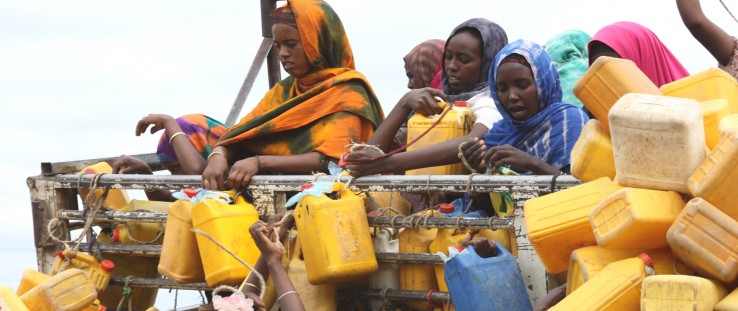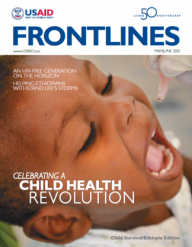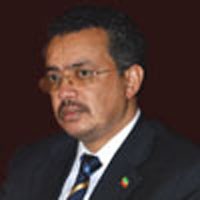

FRONTLINES: You were chair of the Global Fund to Fight AIDS, Tuberculosis and Malaria, chair of the Roll Back Malaria campaign, and you’ve been described by former President George W. Bush as one of the best health ministers in the world. What is your advice on how to become a world leader in health?
DR. TEDROS: I think what I agree is that we have the best strategy, and also a very strong political commitment by our government. That’s what is really making things happen.
FL: What are your impressions of working with USAID over the past five or 10 years?
Tedros: Our working relationship with USAID is really something that I am grateful for. From the start, we set our own priorities. We set where we would like to be and how to get there. And I’m really glad that USAID supports us based on that: It is helping us to make progress and to get good results.
Related Content
When I work with USAID, we focus on two things. One is saving lives now, but at the same time we are building the system for the future. Our partnership has been based on this understanding, and it has been key to our progress. And as a result, Ethiopia is not only saving lives now, but also building our health system.
For instance, USAID has helped us in building a new health-management information system; in building a new pharmaceutical finance and supply system; and also in building up health-care financing. USAID’s support in crafting the new health insurance bill is much appreciated. These new systems are preparing the health sector for the future. I really cherish our partnership, and I’m very grateful for the support we are getting.
FL: Ethiopia has made major investments in front-line health workers, hiring and training roughly 35,000 female health extension workers who’ve contributed significantly to better health outcomes in rural areas. How do you plan to ensure the quality of the health workers, retain them and develop a career pathway for them?
Tedros: Their retention has been considered right from the start, when we started the health extension program. We made sure that the health extension workers actually come from the rural communities, from their respective villages. If we cannot find a high school graduate from a rural village, then we take one from a neighboring village or from the same district. So that’s helping, and the attrition is less than 5 percent. We have also developed a strategy for health extension workers to move up the career ladder, earn higher salaries and progress. The good-performing ones and the bright ones can get additional better training to earn a degree, become a nurse, a health officer, a midwife, a nurse practitioner or even a physician.
FL: What about the dearth of doctors?
Tedros: Yes, there is a serious shortage. We believe the root cause of the problem is a mismatch between supply and demand. Of course, brain drain contributes to the shortage, but we don’t believe that brain drain is the main cause. The main cause is not training enough and not supplying enough, even though the demand is really high. So our government designed two strategies: One is a flooding strategy, and the second is a retention strategy. In the flooding strategy, we’re trying to really produce enough to satisfy the demand. And in the retention, we’re introducing financial and nonfinancial incentives to keep them. Based on that strategy, our enrollment of medical students increased from 300 six years ago to 3,000 this year. The past three years, we have been enrolling an average of 1,400 per year. So we hope in the coming five, six years, the crisis will really start to abate significantly and stabilize.
FL: Can you describe the new tool at the health extension workers’ disposal: the Women’s Development Army?
Tedros: Yes, these groups—they could be women’s groups or other groups—are mobilizing communities, speeding up the scale-up of best practices through peer support. The communities themselves can help each other.
For example, a major obstacle to improving maternal mortality is discouraging traditional home births. When I visited Tigray recently, I was really encouraged by what I saw. Institutional delivery has really soared significantly. I was trying to go through the records of the health extension workers, and I really couldn’t believe it. A few years ago, institutional delivery was less than 10 percent. But now in some villages, more than 50 and even up to 70 percent are giving birth in health facilities. We can see the benefits of really working with women’s groups in creating this environment of peer support.
To make these women’s groups really work in the whole country, they need to be able to address three things: maternal mortality, neonatal mortality and prevention of mother-to-child transmission [of HIV/AIDS]. All three are addressed mainly during the same short period from pre-delivery to one month after delivery, and is where the peer support in encouraging use of health services can have a major impact. So focusing on that and on skilled or institutional delivery can really turn things around.
FL: How is Ethiopia planning to cope with possible international budget cuts?
Tedros: That is something that we have really worried about. The past 10 years have been exceptional in global solidarity, and the financing for global health was really unprecedented. But now we’re seeing some decline, and I think it’s really important that we try to cope with the possible international budget cuts.
We have been trying to do that already in the past four, five years. One of the strategies we use to cope with any shocks was to focus on primary health care, which can be run at low cost but which can have a tremendous impact.
And the second part is investing in health-care financing and raising domestic resources. Our government’s support [to the health system] has been increasing from year to year. Now we’re starting health insurance, which will help raise domestic resources as well.
And then system-building: Over the past five, six years, we have been focusing on systems issues: management information, pharmaceuticals and human resources, among others.
FL: Can you explain how you’ve been able to “task shift” in your health sector strategy, particularly using the health extension workers. Is that helping keep costs down?
Tedros: Yes, that’s why I said that we tried to address the cost issue from the start. We preferred to focus on low-cost but high-impact interventions so we can run our health system. So services that used to be given by nurses are now being given by health extension workers.
There is an article that’s published by the London School of Hygiene that focused on this—on shifting some services from highly skilled to low skill, which can actually be implemented by the low-level health professionals.
FL: Aren’t you also starting a new program for midwives?
Tedros: Yes, we started acceleration training, and we enrolled more than 1,600 last year. And in the next two years, we will, I think, finish the accelerated training by training between 5,000 and 6,000 more. That is part of the flooding strategy.
We use the same strategy to train health officers, who manage our country’s health centers. In just four, five years we trained over 5,000. We’re training some of them on emergency lifesaving surgery interventions, like Caesarean section, to save mothers, because we don’t have enough surgeons or OB/GYN specialists in the country. So this is exactly the type of task-shifting we were talking about: from surgeons or OB/GYN specialists to health officers or non-physician clinicians.
FL: What insights can you share with colleagues in other countries considering using frontline health workers to reach sick children? And what were the conditions that have made the program so successful in Ethiopia in terms of reducing the child mortality?
Tedros: Well, if we start from the [Millennium Development Goal] targets: reducing maternal mortality, reducing child mortality and also addressing or tackling HIV/malaria/TB, the main strategies are health promotion and disease prevention. And health promotion and disease prevention can be properly addressed by using the primary health-care system and the frontline health workers.
FL: Given there is still more work to be done in the area of child survival as well as maternal and newborn health, what is your vision or plan for the next five years? Tedros: I would split it into two. The 2011 DHS [Demographic Health Survey] result was released in March, and showed that under-5 mortality had declined dramatically from 123 deaths per 1,000 live births to 88. So, for us, this is really a good incentive to help us to even aspire for more.
Our first objective is an ambitious and compelling child survival goal. And what we’re aspiring for in Ethiopia is to achieve more than the MDGs by 2015. We’re expected to reduce under-5 mortality from the existing 88 to 67 per 1,000 live births but we believe that we can even reduce it even more. So it means we are revising our MDG targets. We think we could go down even to between 40 and 50.
But of course, although the under-5 mortality has declined dramatically, neonatal deaths have only declined very modestly. And they contribute up to around 42 percent of the total under-5 mortality. So another focus will be, of course, on newborn deaths.
But this is not about child survival alone; this is about maternal health and survival, another area where we really haven’t made progress. Especially in Ethiopia, considering the situation, I think taking [maternal and neonatal health] together as a pair is key, focusing on care during pregnancy, delivery, and then during the crucial month post-delivery which is really the most risky both for the mother and for the child.
A mother should not lose her life while giving life, and the practical step towards realizing that is for all deliveries to be at a health-care facility, supported by a skilled health professional. So the two combined—the first months from pregnancy to the first months of the child’s life—is very critical.
I think if we can really implement the new strategy we have started, we will improve the maternal situation in Ethiopia. And we’re very excited and very hopeful. This is not simply dreaming, but believing that it’s possible. We have a practical solution to make it happen.










Comment
Make a general inquiry or suggest an improvement.